“Without data, you’re just another person with an opinion.”
-William Deming (1900 – 1993)
It is my view that data is the thread that runs through the fabric of an organisation. It can be the lifeblood of responsive evidence-based decision-making for business, operations, governance, security and strategy. If we can transform data to information, knowledge and ultimately to actionable wisdom, it can also be the lifeblood for continual improvement and prosperity.
The purpose of this article is to raise data awareness to aid its understanding, appreciation and context.
By sharing experiences and highlighting key considerations it will inform strategic thinking.
The first industrial revolution began just over 250 years ago. While, another followed in just under 150 years, and we have been in the midst of a third in recent years. Rather than using steam power or electricity, this third revolution is being driven by data as its fundamental raw resource. It is evident that data is a global commodity.
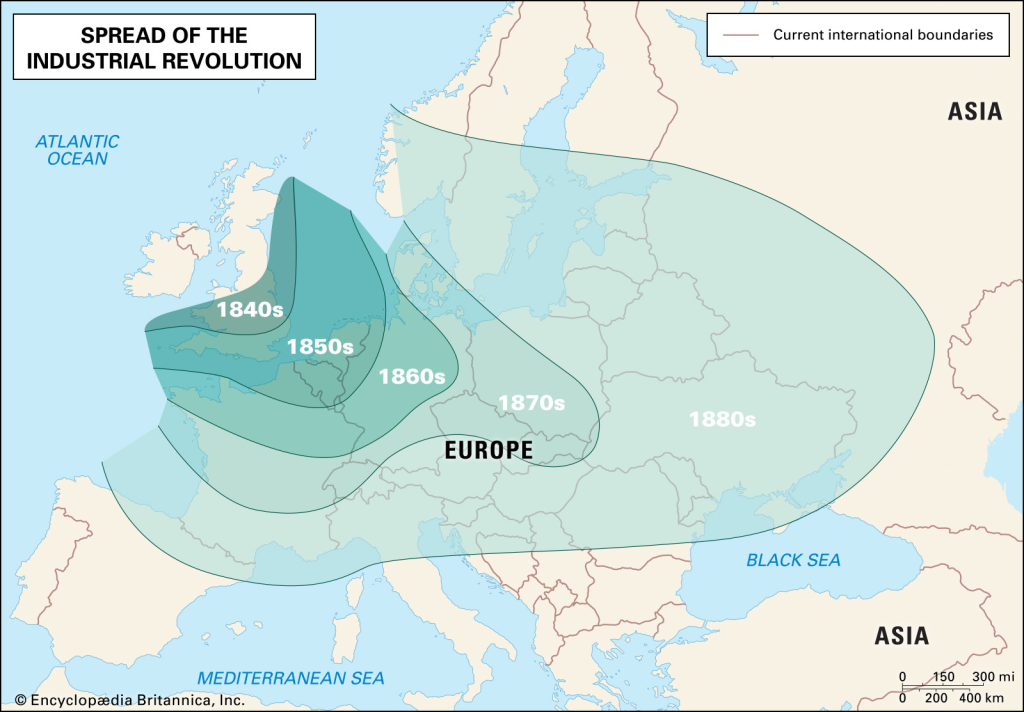

These revolutions were essentially a disruptive shock to the status quo and acted as a catalyst for massive realignment. Contributing factors included emerging technology, innovation, thinking, processes and trade opportunities. These revolutions took decades to gain traction and come to pass.
In 2020, the world is living through a new disruptive shock with the COVID-19 virus as the catalyst. We are in a time of realignment and even more so, in a time of massive responsive innovation. This catalyst is gaining traction on a daily basis. Perhaps, way into the future, historians may see this time as the fourth revolution.
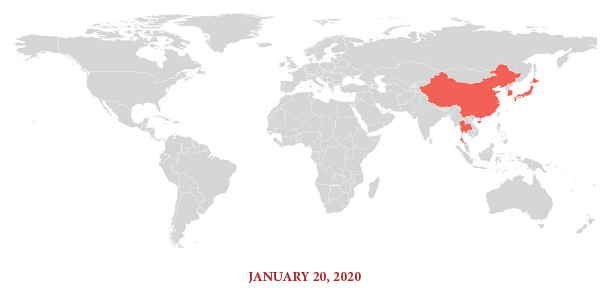
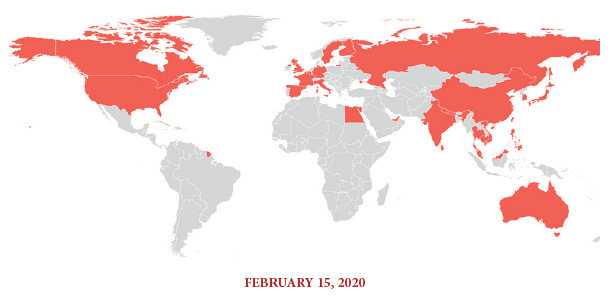
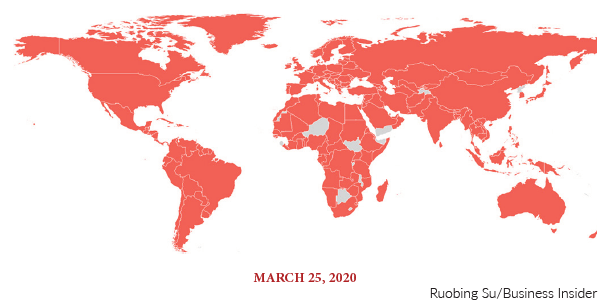
In my view, data per se is ubiquitous and ever-present. It may be human-derived such as manifested through ancient cave drawings, the navigational maps of the early explorers or even the periodic table. It may be derived from the natural world such as DNA and virus sequencing. Data can be seen as a motivating record in time. In this day and age, data is synonymous and infamous with the social media. It is even more so with COVID-19, with reporting, testing, forecasting, disease control and lockdowns driven by data.
This article focuses on the data ultimately stored on computer systems, which is more commonly known as “digital data”. I’ll leave the cave drawings and virus sequencing to a later date.
The vast majority of users in organisations are using pre-built software systems. From their perspective, the type of underlying data being used is entirely immaterial to their needs. The inference here is that the boundary of organisational system capabilities is an artificially imposed limiting factor to those organisations.
It was reported in May 2019 that 60% of the organisations report that the majority of their data is still not being used at all. This “dark data” represents an untapped commercially valuable resource, while at the same time, representing data governance and security challenges.
In my experience, it can be challenging for organisations to consider and scrutinise their dark data. Especially, as it may expose issues that they may need to own up to and address, on top of their existing business priorities. The most successful business outcomes are from data when a data-driven mindset is prevalent. I have coached extensively on data-driven mindset over the years and I can attest that it is a deeply transformative, positive and effective characteristic for continual improvement and prosperity. The data-driven mindset does insist on collaboration and leadership.
At this point, it is necessary to establish some building blocks around data.
There are essentially two types of data, structured and unstructured. Structured data has been tried and tested in systems used by the masses for decades. Day-to-day examples include population censuses, application forms, human resource records, sales reports, emails etc. The way structured data works is that everything is stored in a predetermined and precise format in tables with fields and field values. Tables are then chained together to reinforce structure. This is illustrated below.
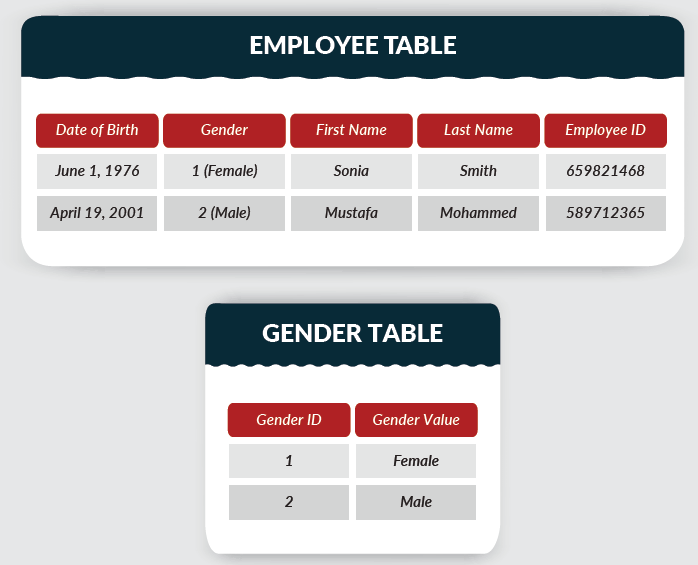
For systems using structured data, all permutations and combinations of questions and queries (i.e. capabilities) are and must be determined ahead of time. This is before any data is ever created and written to a record. This can be a very daunting task. How data is organised, is referred to as a schema. The predetermined schema for structured data is known as “schema-on-write”. This approach is well-established and can lend itself nicely to reporting and business intelligence tools for closed and very well-understood systems.
Typically, only those involved in performance, development, security, analysis, audit and compliance would be interested in the data structures. Users focus on tasks and, on occasions, innovative workarounds.
The critical limiting factor for systems relying on structured data is that they cannot adapt to new or emerging requirements. Therefore, if new data needs to be added or other modifications made, then the whole system needs to be updated with all the ensuing delivery time, costs, change controls, governance, development, testing, deployment and downtime. If more than one system is involved, then the limitation is amplified.
The time lag from new ideas to reaping business value (time-to-value) is hindered.
Unstructured data is sometimes referred to as big data or machine data or even universal data. In my experience, I find it useful to position big data as focusing on the platforms, storage, and infrastructure necessary to ensure that data is available where it needs to be and when it needs to be. If one was to make an analogy with a home dwelling, big data would be the plumbing and sockets with unstructured data being the water and electricity that flows through them.
It is genuinely easy to muddle terms together, but a clear understanding helps to drive well-formed outcomes. When it comes to data, it is vital for organisations to have a documented glossary of terms, qualified with education. Confusion can be a costly risk.
Rather conveniently, unstructured data means just that. There is no structuring necessary ahead of time, whatsoever. The desired structure is dynamically applied during the querying of the data in the system being used to interact with the data. There are no tables or fields stored and any data can be added from anywhere at will. It also means that new solutions can be rapidly developed, and existing systems can be dynamically adapted and linked with other systems more easily. This is known as “schema-on-read” and is represented below. It allows the asking of different questions of the same data.
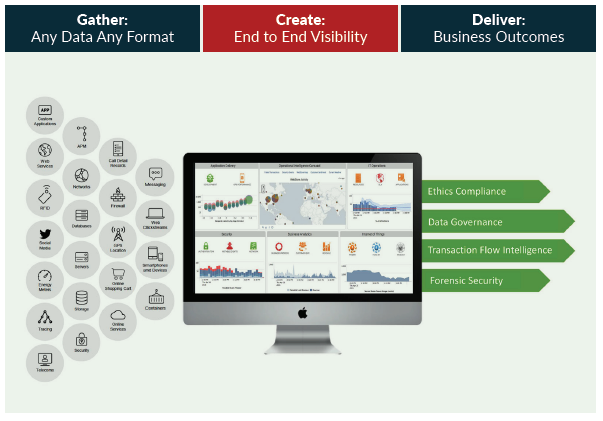
The time lag from new ideas to reaping business value (time-to-value) is rapid.
It is not as simple as using structured data being bad and using unstructured data being good. It all depends on what outcomes are being sought and what the associated usage scenarios will be. In a fast-changing, time-critical, COVID-19-impacted world, being able to harness and ship unstructured data from multiple sources is a key differentiator. This is equally so for cybersecurity.
It is believed that 95% of all data today is unstructured. Bearing in mind that all data is security-relevant and data protection is gaining more and more traction and attention, the case for organisations mastering their unstructured and dark data is compelling. The more we use data to understand customer interactions, the more effective we will be in terms of our engagement around customers’ actual needs and wants, and not what we ‘think’ we should push to them.
ORGANISATIONAL CHALLENGES
One of the challenges facing organisations is strategy. The output of strategy is, of course, deciding WHAT to do next. Strategy in business runs within well-known or well-established parameters. These, to a greater or lesser extent, depend on factors such as domain knowledge, business maturity, market maturity, research, ethics and forecasting. The strategy needs to be informed and well thought out. Given the opening statement that “without data, you’re just another person with an opinion”, data must have a role to play in forming strategy. I would position data analytics as the techniques and science applied to data to create business value and timely insights that can create an informed strategy. However, with the majority of organisational data being dark data, are we are unwittingly harbouring decision support knowledge? Data analytics can be used in facilitating feedback hooks, metrics, monitoring and analytics to assess strategic initiatives and alert on deviations, diminishing relevance and prevailing threats. Perhaps, if Blockbuster Video consumed data feeds around competitive intelligence, and market and technology trends, they may have come up with the strategies to survive Netflix.
COVID-19 is a massive shock and disruptor for organisational strategy. An esteemed banking colleague said to me that since COVID-19, his customers have changed. Life has changed. With interactions abruptly moving away from being physical, there is a need to drive genuine and verifiable trust in data. This is impactful for forming strategies. Are we sure that the initiatives and campaigns to execute and deliver on our strategic goals are still relevant and productive in the light of COVID-19?
SUCCEEDING WITH DATA – KNOSTER MODEL
In 1991, Timothy Knoster made a famous presentation to The Association for Severely Handicap (TASH) conference in Washington D.C. He introduced the “Knoster Model” for managing complex change. The model has several constituent components. For change to be successful, each of the components needs adequate consideration to ensure the desired outcome of change.
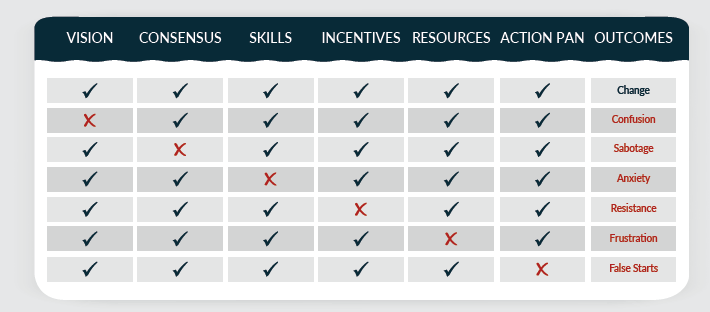
SUCCEEDING WITH DATA – DATA VALUE FRAMEWORK (DVF)
In my years of experience supporting organisations around the world, an all too common challenge for these organisations, that required my assistance, was both comprehending and navigating the data-driven landscape. In response to this, I created the Data Value Framework (DVF) and presented it in Washington D.C. at the annual worldwide Splunk conference in 2017. It is illustrated below.
Similar to the “Knoster Model” the DVF segments the data landscape into several key phases. Each phase has outcomes directly attributed to considerations. The primary objective is delivering business outcomes to a sustainable cadence whilst driving business value and organisations adoption. Agile and ITIL approaches are fully supported. The framework is especially useful for mapping to existing organisational capabilities and parallel collaborative progression. If one phase is not delivering desired outcomes, then this is flagged for correction to ensure fast failing and continual improvement. The DVF supports strategic thinking and a data mindset. Being a framework, an organisation can choose to prioritise or adapt to their prevailing context. These actions are taken from a position of knowledge.

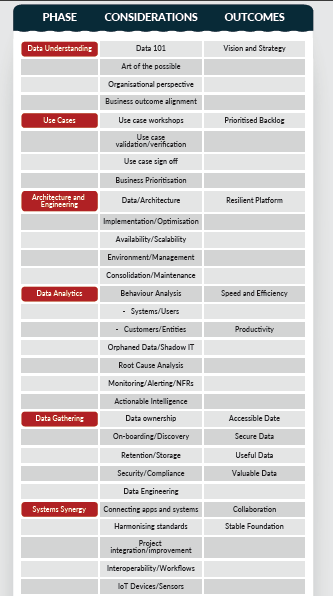

DVF USE CASE WORKSHOPS
Having data, whether structured or unstructured, adds zero business value except for possible compliance. Having a data platform, regardless of the cost or complexity, also adds zero business value per se. The data and the data platform are mission-critical, but business value is created only by realising use cases. The use case is the catalyst and, in my experience, the most valuable commodity in the data world.
The term “Use Case” can mean different things to different people. The “DVF Use Case” is the definitive record attributed to all work been undertaken in pursuance of business outcomes. The use case idea may come from absolutely anywhere and should be without any prejudice.
A brainstorming session or an anonymous idea box are both equally valid and valued.
During a use case workshop, the library of use case ideas is explored from a number of objective perspectives. The goal is to refine the idea in the context of the overall business and prepare it for progression. Having a use case library is essential for visibility, business prioritisation and to avoid duplication across the organisation. As ideas progress through workshops, peer review, business review, business case and change control processes, the definitive use case record expands accordingly and use case artefacts are also added.
POTENTIAL USE CASE JOURNEY SNAPSHOTS

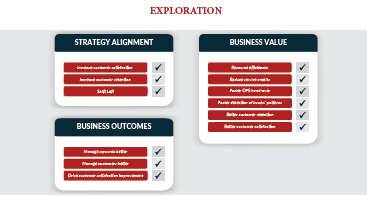


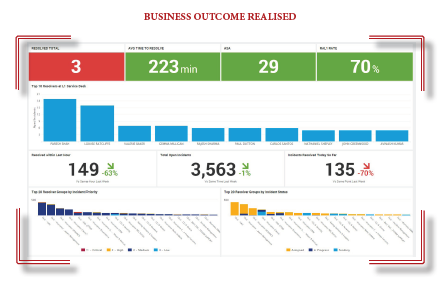
FUTURE THINKING
I have been giving consideration to codifying and subsequently creating a governance and compliance framework around “ethics in data analytics”, underpinned by research, teaching and innovative use of technology such as blockchain. This would also seek to codify trust.
I believe that this may have potential for complementing ethics, oversight, governance and compliance in Islamic finance and banking with the right collaboration. Please do let me know if this may be of interest to you.
CONCLUSION
To succeed with data, is a reality and a necessity for organisations wishing to adapt and prosper in this revolutionary age. I would encourage organisations to engage with the data mindset and to give serious consideration to the business outcomes and transformations it can empower. Whether this forms an initiative, or a complete strategy is a matter for each organisation to explore. However, irrespective of the decisions made by organisations, the impact and dependence of data in our modern world is set to grow exponentially and now even more so in the wake of COVID-19.



